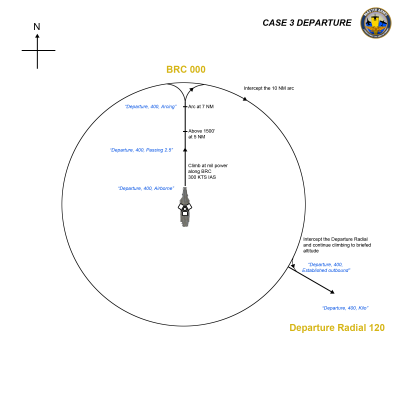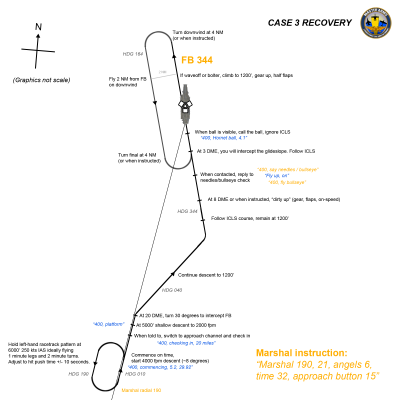CASE 3
Home >> Standard Operating Procedures >> Carrier Ops >> CASE 3
This section holds all CASE 3 procedures that are relevant for our use in DCS.
Main Sources: https://www.cnatra.navy.mil/local/docs/pat-pubs/P-816.pdf and replies from GB.
Innehåll
What is CASE 3?
The short answer is that CASE 3 is flown during night, or during the day if the weather is really bad. For a more technically correct definition: CASE III departures are flown at night and when weather conditions are IMC (WX below 1000-5), and a controlled climb is required. CASE III recoveries are used for all night operations, as well as during the day when the weather is below Case II minimums (less than 1,000-3).
Departure
During briefing you should have received a departure radial and altitude. In this example, the boat's course (BRC) is 000, the departure radial is 120, and your flight's departure altitude is 20000'.
Launching
- We normally don't use a separate departure channel, but remain on the tower channel (Ch 1 305.00) during departure.
- For DCS visibility reasons, before taxiing, turn on full position lights, formation lights and landing/taxi lights. (to make sure you can find the catapult and that other peope can see you, since we don't have plane directors. IRL aircraft are dark until turning the formation lights on just before launch)
- Line up and hook up on the catapult.
- Spread wings. For Hornets, check half flaps and trim to 16 degrees or more depending on weight.
- Launch with mil power or afterburner as preferred, with 30 second intervals between each aircraft.
- Call out when airborne. Example: "Departure, Chevy11, airborne".
Climbing
- Set throttle to mil power and immediately start climbing straight ahead along the BRC, using pitch control to maintain 300 kts IAS.
- When passing 2500' call it out. Example: "Departure, Chevy11 passing 2.5".
- When reaching 7 DME, call out that you're arcing. Example: "Departure, Chevy11 arcing".
- Turn into the 10 nm radius circle in the direction of the departure radial (right, in this example). Continue climbing and make sure your right wing on the HSI is pointing towards the boat so that you are always at 10 DME.
- Turn the course line (if available) to the departure radial (120 in this example).
- Use any available means (radar, datalink, SA page) to make sure you're not conflicted with other aircraft.
- When you are about to reach the course line, turn onto it. After the turn the boat should be on your 6 o'clock.
- Call outbound. Example: "Departure, Chevy11, established outbound".
- Level off at your flight's departure altitude (in this example, 20000').
- Call when mission ready, prepared to leave the frequency. Example: "Departure, Chevy11 Kilo".
Recovery
Arriving to the Carrier Control Zone
- Perform HAIL-R checks:
- H - Hook down.
- A - Anti-skid off / Altimeter. (Also set/confirm Hook Bypass to CARRIER)
- I - Instruments. (Turn on ILS, general checks)
- L - Landing weight / Lights For Hornet: Max 34k lbs. Full position and formation lights. Turn on landing lights (for DCS platcam visibility reasons)
- R - RADALT (Pilot preference. 1000' is recommended to warn if accidently decending below 1200')
- At 50 nm DME, switch to Marshal channel (Ch 16 261.00).
- Contact Marshal stating your position, altitude and fuel state. Marshal will provide your Marshal instructions.
- Comms example: In this scenario, you are assigned 21 nm on the 120 radial at 6000 feet with a push time of 32 minutes over the hour.
- You: "Marshal, Chevy11" (i.e Chevy One One)
- Marshal: "Chevy11, Courage Marshal"
- You: "Chevy11 marking Mother's 070 for 48, angels 14, state 6.5"
- Marshal: "Chevy11, Courage Marshal, Case 3 Recovery, CV1 approach, expected final bearing 344, altimeter 2992"
- Marshal: "Chevy11, Marshal 120, 21, angels 6, expected approach time 32, approach button 15"
- You: "Chevy11, Marshaling 120, 21, angels 6, time 32, approach button 15"
- Marshal: "Chevy11, Readback correct."
Note 1: The distance and the altitude will always be at a differance of 15. Example: Distance = Angels + 15 = 6 + 15 = 21
Note 2: "CV1" is the kind of approach described here. We never do CV2, so you don't need to learn about it.
Entering the Marshal Stack
- Set your course line (if available) to the assigned radial and fly on it towards the carrier. Make sure you're on the assigned altitude at least 10 nm before reaching the stack.
- Slow down to 250 kts IAS as you enter the marshal stack.
- When reaching the point (in this case 21 nm DME) turn left into a race track pattern, holding until your push time has come. Ideally, you should be flying 2 minute turns and 1 minute legs.
- You will need to adjust your pattern in such a way that you reach the push point on time plus/minus 10 seconds.
- The exact shape of your holding pattern is not that important. As long as you keep your altitude, make left turns and reach the push point on time, you're doing fine.
- If you reach the push point reasonably on time (plus minus 15 seconds or so), make your commence call on your assigned time. Don't wait until you are exactly on your assigned point. If you miss the time drastically (more than ~15 seconds), communicate this clearly.
Commencing
- When your time comes to push, call out [Callsign] commencing [fuel state]. Example: "Chevy11, commencing, 5.2".
- Make sure you keep 250 kts IAS and start a 4000 fpm dive, heading straight towards the carrier, along your assigned radial.
- When you reach 5000', call out [Callsign] platform [fuel state]. Example: "Chevy11, platform, 5.0".
- Immediately after the platform call, shallow your decent to 2000 feet per minute.
- Marshal will tell you to switch to the approach channel. Example: "Chevy11, switch Approach, button 15".
- Switch to the approach channel (normally Ch 15 263.00) and check in. Example:
- You - "Chevy11, checking in, state 4.8".
- Approach - "Chevy11, final bearing 344".
- Set your course line (if available) to Final Bearing.
- At 15 DME you need to perform an arcing turn so that you are lined up on Final Bearing before 12 DME.
- Level off at 1200'.
- You may want to clean up your HUD. For instance, in Hornets, remove the time from the HUD (HSI, TIMEUFC, ZTOD) to make sure it's not obstructing the IFLOLS when landing.
Final Approach
- Through the DCS comms menu, contact ATC/Stennis/Inbound. Make sure you're doing this call on the right AI Tower frequency (Ch 2, 264.00). You may want to use the right-hand Com2 AUX radio for this call, so you don't have to leave the approach channel.
- At 10 DME, start landing checks. Remain at 1200'. Extend gears at 8 DME. Make sure you're flying on-speed in landing configuration at 6 DME. Approach may instruct you to "dirty up" (i.e get into landing configuration) earlier or later than 8 DME if needed.
- Approach will soon ask you to "say your needles". IRL this is only done for ACLS (which we don't have in DCS). For our purposes, approach wants to know if he's looking at the right aircraft. What you need to do is to reply how you need to fly to get onto centerline and glideslope. Basially, where your ICLS needles are in relation to your velocity vector. If one of them is already centered, you say "on". Example:
- Approach - "Chevy11, say needles".
- You - "Fly up, fly right" or "Fly up, on" or "On, fly left" or "On and on".
- Approach - "Chevy11, fly your needles" or "Chevy11, fly bullseye".
- For our purposes, it doesn't matter whether approach replies "Fly your needles" (successful ACLS lock) or "Fly bullseye" (unsuccessful ACLS lock). Just fly your ICLS needles.
- Don't fly up above 1200' to "catch" the glideslope. Instead, remain at 1200' until you fly "into" the glideslope, and start decending, following the ICLS down towards the boat.
- Around 1-2 DME, you should see the ball. From now on, fly the ball. Ignore the ICLS for vertical corrections.
- Perform the ball call. [Callsign] [Aircraft type] Ball [Fuel state]. Example:
- You - "Chevy11, Hornet ball, 4.1".
- LSO - "Roger ball!".
- Fly the ball and the LSO instructions until you touch down. When you touch down, don't anticipate catching a wire. ALWAYS engage full power (mil power, or even afterburner if you think you might need it) until it's clear that you are standing still on the deck.
- Cut power to idle and fold/sweep the wings. If the wire doesn't pull you back and release (for DCS reasons), try turning the nosewheel left and right a couple of times. When the wire has released, raise your hook, taxi off the landing zone and park on the bow or wherever you are instructed to.
Bolter Pattern
- If you miss the wire (bolter) or you are waved off, continue flying on final bearing past the boat, climbing to 1200'.
- Raise the gear and raise the flaps to HALF flying at 150 kts IAS to save fuel.
- If no instructions are received by 4 DME upwind, contact approach. If unable, turn downwind remaining at 1200'. Pay close attention to the HSI making sure your downwind is 2 nm offset parallel to the final bearing line.
- Call out when abeam. Example: "Chevy11, abeam".
- If no instructions are received by 4 DME downwind past abeam, contact approach. If unable, turn final. Intercept the ICLS and fly another approach.
- If on downwind you're told to intercept the final bearing at 4NM on downwind, fully configure (full flaps, gear down) when starting the turn. At 6NM, halfway through the turn. At 8NM+ wait until established on Final Bearing.
Questions and discussion topics
- In DCS, with many aircraft in the pattern, does it work if everybody calls Inbound just after commencing (for instance, when switching to approach channel)?

